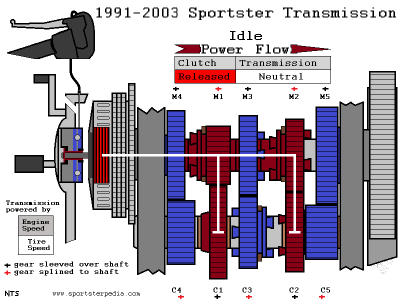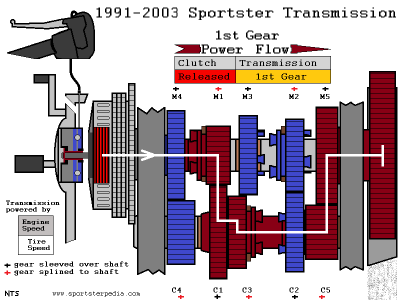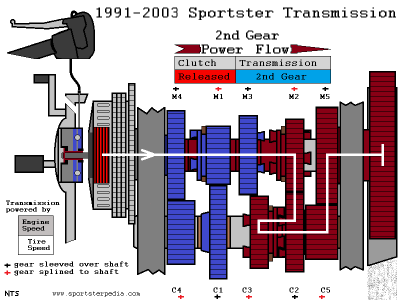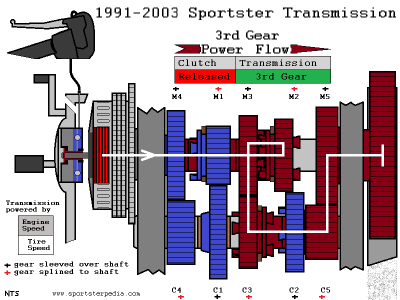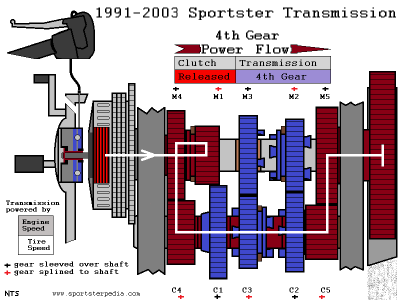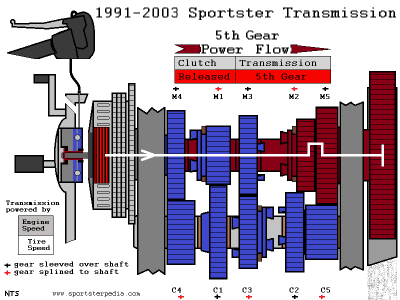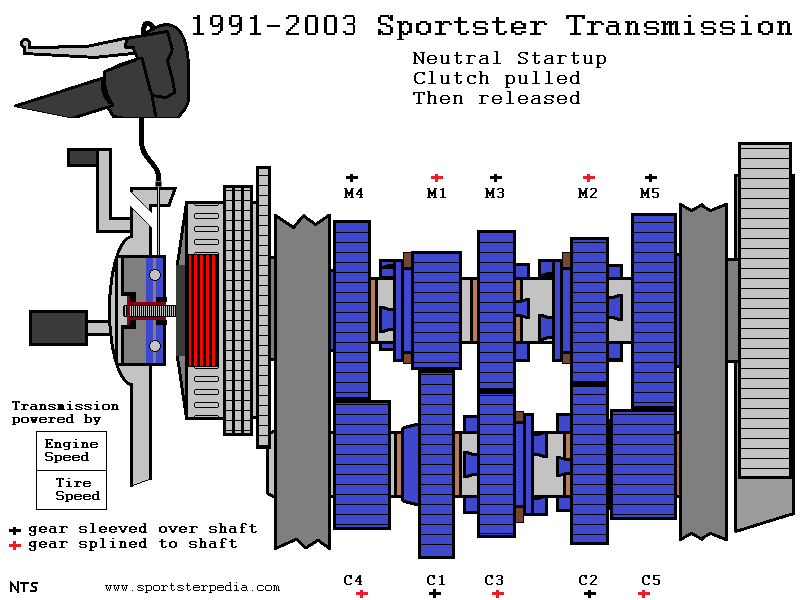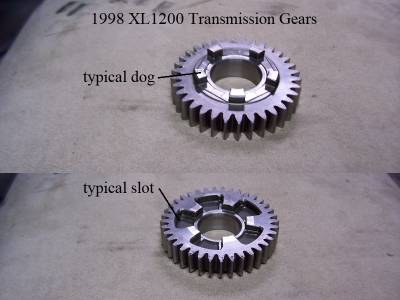Table of Contents
REF: Service Procedures 11L

Gear Dog Damage: Inspection and Causes
This article is written in defense of the dogs on the gears.
For without the dogs, the pretty gear teeth are entirely useless.
Overview of the Gears
The drawings below show the power flow (how power is transmitted) thru the transmission when in different transmission 'GEARS'.
The various individual 'gears' inside the transmission which are involved are named Mx for Mainshaft gears or Cx for Countershaft Gears.
About Splined and Sleeved Gears:
There are '+' signs above/below each gear in RED or BLACK. Such as M4 has a BLACK '+' and C4 has a RED '+' and M1 has a RED '+'.
The BLACK '+' gears are SLEEVED over the shaft on which they are located. This means they can turn separately from the shaft unless
otherwise engaged.
The RED '+' gears are SPLINED to the shaft on which they are located. This means they always turn whenever that shaft turns.
The SPLINED gears (M1,M2,C3) are sliding gears, movable on the shaft so they can engage neighboring SLEEVED gears, using 'DOGS' (like fingers) to intermesh between those gears.
SPLINED gears C1 and C5 are not sliding gears, but rather fixed in place.
By the various positions of the sliding gears (M1,M2,C3), the transmission can be placed into various GEARS (including IDLE).
Notice that every SPLINED gear has a usable SLEEVED gear on the opposite shaft.
These SLEEVED gears will spin with the SPLINED gears, even when no power is being transmitted thru them.
Since they are SLEEVED, they cannot flow power unless engaged by DOGS.
The clutch is always directly connected to the Mainshaft. When the clutch is engaged, it drives M1 and M2 because they are SPLINED gears.
At the other end of the power flow, M5 is a SLEEVED gear which is directly connected to the final belt 'Drive Sprocket'.
When the clutch is engaged in any GEAR, power always flows out of the transmission thru the M5 gear to the Drive Sprocket.
Notice that the 1st to 4th GEAR drawings show 5 gears are involved in transmitting power from the clutch to the Drive Sprocket.
In each of these GEARS, power is transmitted thru the countershaft using C5 to drive M5 (and thus the Drive Sprocket).
Various sliding gear DOGS must to be engaged to one of their adjacent SLEEVED gears to have power flow on the countershaft.
(even though the 'teeth' on the sliding gear may not be involved in that power flow path)
Once the SPLINED gear with DOGS engages to a neighboring SLEEVED gear, that SLEEVED gear is now locked to and turns with the shaft.
When the transmission 5th GEAR is selected;
The Mainshaft SPLINED M2 gear is moved so it's DOGS engage the M5 SLEEVED gear, thereby flowing power from the clutch to the Drive Sprocket in a 1:1 ratio.
A chart for neutral is included below since, technically, power flows from the 2 SPLINED gears to the 2 SLEEVED gears when the clutch is engaged, although power ends there.
The Countershaft SLEEVED gears in that situation are 'idling', with no way of locking themselves to the countershaft to flow power elsewhere.
Click on any chart to enlarge: 1)
The animated image below shows how the gears are positioned and then moved to attach to their mating gears throughout the gear range.
This may be helpful in determining which gears affect others when accessing the parts.
All shifts in the animation are considered “good shifts” with the dogs sliding into gear as should be.
Bad shifts make the gear dogs hit sides before the sliding gear enters the stationary gear's “dog land”.
The spinning gear eventually finds an opening to mate but slaps corners while mating, and damages them.
It's also important to note the source of power changes during a ride.
When you are on the throttle, the motor is driving the transmission then the rear tire.
When you let off the throttle, the rear tire is trying to drive the transmission (or countershaft) at the same time.
So there is a push/pull going on inside the transmission and the stronger power prevails.
During this time is when the dogs are apt to have lower clamp force on their opposing dogs/slots and a slight separation is possible.
In the animation;
- While shifting from 2nd to 3rd as an example;
- First, C3 slides left away and out of mesh with C2.
- C3 slides to the left, releasing it's grip on C2. That is accomplished easier with the clutch disengaged.
- Due to the undercut dogs, when C3 tries to pull out of mesh, it needs to either slow down or speed up C2 a bit to break mesh.
- M2 was driving C2 with the clutch engaged which wouldn't allow C2 to slow down.
- So removing the motor speed off the mainshaft (clutch pulled) kept M2 from driving C2 (mainshaft's power source is just centrifugal force now).
- And that allowed for the dogs to pull apart without excess torque between them.
- The harder these dogs are pressed together, the more possibility there is to chip or mangle the dogs as they separate.
- Next, M2 moves toward M3. And M2 (splined) is spinning faster than M3 (sleeved).
- M3 here is being driven by C3 (splined) which is being driven by tire speed.
- As soon as M2 rotates inside M3's “dog land”, M2 hits inside of M3 and stops rotating for a second until M3 dogs catch up to M2 dogs.
- If both M2 and M3 were being driven by both tire and motor speed, dog engagement would be rougher when these dogs come together.
The above is just one example of dog mesh situations where one non-driven gear has to concede to the driven gear in order to mesh without damaging the dogs.
Gear Dogs and Slots
The transmission gears are engaged by way of gears with dogs (male engagement) and slots (female engagement).
The sliding gears are splined to their respective shafts and turn according to “current” shaft speed.
Gear dogs may either slide into their mating gear slots or mesh to their mating gear's dogs depending on which gears are being mated.
The dogs are undercut starting from the outer corner toward their root. This undercut is designed to keep the dogs from slipping out of gear under heavy load.
The slotted gears are also undercut to match the dog machining.
With a 90 degree angle instead, the sliding gear dogs could simply spin straight out of mesh (pop out) with high centrifugal force.
With the undercut, they can't simply pull out. The sliding gear would have to first separate from dog mesh and then pull out.
The outside edge of the dogs also have a back cut (or chamfer) to help guard against chipping when sliding in or out of mesh against it's mating gear.
The used gears below, as you can see, have no internal splines and are sleeved on the shaft over bearings.
Dog Inspection
Worn Dogs (hopping out of gear)
The gear dogs can wear just about anywhere around them for several different reasons.
The most common thing that happens is when the corners get rounded off instead of being flat on the edges. 4)
A gear may hop out of dog mesh.
It feels like the transmission jumped into neutral for a second and then jumped back in gear.
It's usually a momentary hop-out. In other words, it hops out and then right back in. 5)
So the bike hesitates during acceleration and then jerks back forward again.
This is the common cause of hop-out, although checking the pawl adjustment with a .116“ drill bit per the service manual should certainly be done first. 6)
But you can check that on your way to pulling the transmission.
| Worn dogs 7) | |
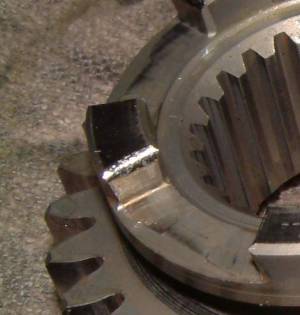 | 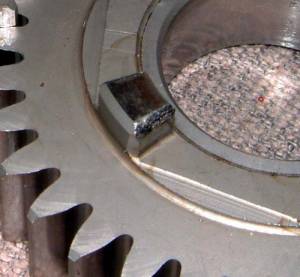 |
The fact the corners are rounded isn't as much of an issue as the REASON they got rounded and the EFFECTED CONDITION of them being rounded.
The corners began as a machined chamfer or specific angle to guard against the edges getting chipped during dog mesh.
The sides are machined so they are a perfect match to and lay flat against their mating dog or slot.
As use (and abuse) happens, the corners get banged into their respective mating gears which mangles (and changes) the side profile of the dog(s).
Now, instead of equal pressure across the side of the dog, the only part of the dog that is mating is the crunched portion.
So the surface tension is shortened and the undercut isn't fully touching which limits the dog's ability to stay in place.
So the gear hops (or backs) out of dog mesh.
Meanwhile, the fork is still trying to hold the gear in mesh and forces the gear back “home” and the cycle continues.
Dog Repair
Repair on the dogs should be done by a competent machine shop that uses a rotary table to make sure all cuts are equal distance and all surfaces are flat.
The undercut will have to be re-machined as well. Basically a new undercut equal to all dogs/slots should do the trick.
For these reasons, it may be cheaper and more reasonable to replace the offending gears with new ones.
Also check all gears that the bad one(s) hooks up to for damage or repair needs before ordering parts.
A lot of OEM gears are now obsolete although you can still find others at HD.
Gears are generally sold in sets (i.e., MS1 and CS1 etc). And technically they should be replaced in sets.
The gear teeth wear into each other and create their own wear patterns.
A used gear may “wear in” a new one prematurely and cause more damage to the set.
Since the primary issue with rounded dogs is the mangled metal raising on the flats of the dogs, a first impression may simply be to file them flat again.
But the problem with that is there are 5 dogs per gear and each rests equally on it's respective mating gear dog or slot.
If you file 1 forward side of 1 dog, you essentially have doomed that point to never touch anything again since the other 4 are still at the level the first was before filing it.
Then you have to file the other 4, then you have check and most likely file the rear side of those 5 as well.
Now when you are done, you realize that only 1 or maybe 2 actually touch their mating dogs/slots (daylight between them when held together against a light).
Then you most likely need to resurface the opposing dogs/slots to try and match them to the new surfaces you created on the first gear.
And when it's all said and done, you'll have 3 or more gears that now “hop out”.
Basically if they are all not the same exact size, you'll get “point loading” where 1 or more dog/slot is slightly forward of the others.
In contrast, racers may do whatever it takes to be in front of the pack.
And they also understand that everything may be in pieces by the end of the race.
So longevity of parts sometimes gets put in the back pocket for current needs.
How Dogs Get Damaged
Bad Shifting Habits
A Sportster is not a 1974 Chevy pickup with a six cylinder motor and manual shift and should not be shifted like one.
Below are a few common things that can cause or contribute to gear dog wear/damage while shifting.
Neutral to 1st on a Cold Start
Firing up in neutral on a cold start is sort of like firing up in 1st gear with the clutch released.
The transmission doesn't disengage from the motor due to stuck clutch plates.
On initial startup, the clutch plates are usually stuck together from thick, cold (ambient) oil temps.
Even with the clutch lever pulled, the engine stays engaged to the transmission since the clutch plates can't pull apart and release pressure on the mainshaft.
So the bike lunges forward with engine RPM still trying to turn the transmission while the transmission is in neutral.
The bike lunges forward slightly until that movement separates the clutch plates.
Afterwards, the clutch lever is then in control of the plates again. This is generally not an issue after the bike has been run for a spell, shut down and restarted.
Or at least until the oil cools to ambient temp again and thickens enough to stick the clutch plates together again.
The mechanics of the situation when shifting from neutral to 1st on a cold start;
The rear tire is not moving so the countershaft is locked dead still and the mainshaft is turning at idle speed.
Pushing the shift pedal towards 1st gear forces countershaft 3rd gear to slide to mate with countershaft 1st gear.
When these 2 gears combine by locking dogs to slots, both the mainshaft and countershaft are now being powered by the motor.
C3 gear is splined to the countershaft and it locks C1 gear to the countershaft. M1 gear is splined to the mainshaft.
C1 and M1 gear teeth are in constant mesh so both shafts are being powered by the motor at this point poised to turn at idle speed.
But, the rear tire is still not moving (default from the weight of the bike and the rider).
How this affects the dogs;
IF the positioning of the dogs and slots is so that they combine together without hitting corners, you'll just get the slight lunge forward.
These gears are tough and the jolt is not as bad on the dog/slot relationship if there is enough contact between them during the jolt.
IF the positioning of the dogs and slots allows them to hit corners before going into each others “dog land”, then the corners on both gears take the brunt.
This can be a rough transition for the dogs and can contribute to wearing on the corners and hopping out of gear.
It's akin to hitting a metal baseball bat on a tree trunk.
The tree (rear tire) just takes on vibration, the bark (slot corner) can get indented and the bat (dog corner) can get indented.
It's a rough transition that can damage the dog corners and cause them to hop out later.
If firing up in 1st instead, you'll still get the lunge forward (even holding the clutch lever in) but the dogs are already meshed with their corresponding slots.
This minimizes the possibility of damage to the dogs and slots.
Delayed Shifting
A “fast shift” doesn't mean slamming the shifter pedal. It means to be sure and shift soon after pulling the clutch.
This retains current speed of both the mainshaft (MS) and countershaft (CS) gears.
If you wait too long after pulling the clutch lever before making a shift, it could cause grinding noises and gear dog damage.
The MS and CS should both be at different speeds but traveling at the same respective speeds both before and after pulling the clutch lever in.
The dogs should ideally not hit side to side during a gear slide while changing gears.
While the mainshaft and countershaft will not be at the same speeds, they are both in a respective speed with the sliding gear engaged.
When the clutch lever is pulled, the mainshaft is not being “powered” by the motor. The countershaft however is being “powered” by the rear tire.
So the mainshaft has the ability to slow down shortly after disengaging the clutch.
The sliding gears on the mainshaft are splined to it so if the mainshaft is turning, the splined gears on it are also turning.
And with all the gear's teeth always in constant mesh, the corresponding gears on the countershaft are also turning (these are sleeved over bearings).
Works the same with the sliding gear on the countershaft with corresponding sleeved mainshaft gears.
The sleeved CS gears also slow down even though the countershaft is being powered by the rear wheel as they are not spline to the countershaft.
They also provide friction on their corresponding mainshaft gears which helps to slow them down, which slows the mainshaft.
If a shift doesn't happen until after the mainshaft starts slowing down, the dogs/slots may not match up and hit side to side.
This slows the sliding gear even more with the fork still trying to force the sliding gear in and the edge of the dogs end up slapping their mating dogs sides.
And the dog corners take the brunt of the blows.
This can end up rounding and mangling the dog corners and cause a gear(s) to pop out of dog mesh with their mating gear.
Lazy Shifting
That doesn't mean slamming the shifter pedal but rather with a enough force to ensure constant travel “to home” of the sliding gear(s) affected by the shift.
A lazy shift allows the (gear to be engaged) to spin normally but slows down and repositions the sliding gear).
So the sliding gear hits the sides of it's mating gear (which is now traveling faster than the sliding gear) and sort of bounces back against shift fork motion.
The shift fork is trying to mate the 2 gears but both gears try to repel each other traveling at different speeds.
Finally, a “window” opens where the sliding gear can enter the mating gear's “dog land”.
So you get the noise that sounds like grinding gears until that “window” opens.
The brunt of abuse once again is on the dog corners.
The gears themselves are pretty tough but constant abuse on the dogs can round the corners and cause the gear(s) to pop out of dog mesh with it's mating gear.
Pre-Loading the Mainshaft
Closing the throttle before pulling the clutch lever will keep from preloading the mainshaft while the clutch is disengaged and will allow for disengagement of dogs without that load on them.
It's important for that load not to be on the gears.
With added load, as the gear combinations separate from one gear to go to the next, the sliding gear is pressed harder against the adjacent gear it is trying to pull away from. That could lead to burring or chipping of the corners with load applied then as they separate.
The dog corners are chamfered to discourage chipping in that instance but that is not a fool proof solution.
Not Using the Clutch to Shift
Sportster transmission gears are always in constant mesh.
So whether you use the clutch or not, the teeth will always be turning together. So stripping gear teeth isn't an issue.
The issue is the load on the dogs while shifting.
Shifting without using the clutch requires rolling off the throttle to take the load off the mainshaft.
But by default, the motor is still engaged to the mainshaft.
The dogs do not all turn at the same speed.
So a sliding gear will most likely be turning at a different speed than the gear it either has to separate from or come together with.
If both these gears are being driven, neither has the ability to slow down or otherwise concede to allow ease of dog mesh.
That will eventually lead to crunching dog corners no matter how experienced one is at speed shifting.
So even if you are very experienced at clutchless shifting and have been doing it for many years, the dogs still take the brunt of this decision.
Clutch Out of Adjustment
Clutch drag can cause the mainshaft to partially disengage (or not fully disengage).
This keeps the engine still powering the transmission (at X degree) when the clutch lever is fully depressed and preloads the mainshaft while making a shift.
This can also lead to damaging the gear dogs as they try to mate with both the engine and rear tire loading the transmission.
Click Here to see the Evo clutch page in the Sportsterpedia.
Shifter Out of Adjustment
The shifter assembly has designed “slop” or looseness, built in by the factory, to buffer the various conditions involved with the shifter and the transmission.
The shift pawl setting is done by using a #32 (.116”) drill bit into the hole in the detent plate between the pawl and top pin on the shift drum.
This isn't as easy as that since the shaft assembly will move around while you are attempting this procedure.
Once you have made the setting, put everything back together, you may find shifting not as you want it to be.
Don't be afraid of pulling it back down to check/readjust that setting.
The shifter being out of adjustment can affect how much or how little turning force is applied to the shift drum.
Neutral to first is a half throw of the shifter while 1st to 2nd is a full throw of the shifter.
If the pawl setting isn't right, it could affect how fast or at what degree the shifter moves the shift drum to forks to sliding gear.
This could basically create the same scenario of missed or lazy shifting and clanking dogs = damage to the dogs.
If you are sure the adjustment is correct, you may need to dig deeper looking for other parts in need of repair.
Click Here to see the page Setting 1991-2003 Shift Pawl Position in the Sportsterpedia.
Worn Parts
Below is basically a list of possible wear conditions that could cause shifting problems.
Any hinderance to the sliding gears for whatever reasons could contribute to gear dog wear.
However, worn parts are generally described as inherent with use and the prime contributing factor to dog wear is generally associated with shifting habits.
Click Here for more detailed information with pics of the associated wear discussed below.
Shift Forks
The shift forks are a brass/bronze material. Excess wear from the forks may show up as brass “flakes” in the primary oil.
The job of the shift fork is to deliver the gear to the right spot, not to hold it there. 8)
There is designed slop in the shift forks just as there is with most of the shifting components.
The ID of the round end of the forks slides along the shift drum but with a wide clearance.
So there is some slop in that connection alone but that connection also allows uninhibited side movement of the forks.
Worn fork pin holes:
Each fork ID has a pin hole with a solid pin through that sits in a groove in the shift drum.
The pins just sit there with a cotter pin on top of them (not thru them) to keep them from coming out of their bores.
The pins have a habit of wallowing their bore holes during operation which could eventually lead to a gear not fully seating in it's mating gear's dog land.
This could lengthen the time the gear actually hits home to mate or serve as an accomplice to a gear popping out of home place.
Scars/grooves in the bore IDs:
The fork to drum clearance is pretty wide but the fork IDs are relatively smooth still when new.
The round end of the forks can get scarred and/or grooved by the sharp edges of the shift drum channels when a gear backs out of dog mesh.
The gear forces the fork to reposition itself against the drum and the fork ID gets rammed into the sharp edges of the drum channel(s).
The grooves do not necessarily present a huge problem unless they are jagged or scrubbed up enough to hinder movement of the fork along the drum.
It's possible to lightly sand the fork ID and reuse the fork unless the damage is excessive.
But until addressed, the damage can allow for erratic movement of the gear towards it's intended home position.
Countershaft/Mainshaft
Bent shafts:
Bent shafts will hinder movement of the sliding gears as well as create more pressure against each shaft which creates more heat in the system.
Shaft Thrust Washers
Removing thrust washers can distort them and re-using them can end up with pointed edges to catch or hinder movement of the sliding gears.
The sliding gears will slide over the area where the thrust washers sit and the washers should be tight against the respective shafts.
The washers keep the stationary gears from moving side to side.
A loose or worn thrust washer can allow the stationary gear to reposition itself and/or hinder the sliding gear from going home.
Shift Drum
Worn/damaged shift drum channels:
The shift drum has 3 channels cut into it and the fork pins travel thru these channels.
As the drum is rolled by the shifter mechanism, the channel directions change to whatever direction need for the next gear change.
These channels run front to back until a gear needs moving and the respective channel turns so the pin can carry the fork/gear toward/away from the adjacent gear.
The channels are wider than the pins = more slop in that connection also.
It is conceivable that the slop mention so far is designed to allow some flex of the gears when they don't line up for a proper shift.
If the dogs hit side to side, the slop allows a momentary stop or slowing of delivery so the dogs can mate when the window of opportunity arrives to do so.
The channel edges are cut sharp when new but not razor sharp. They get sharper as the pins are forced against them during shifting.
If a gear pops of dog mesh, it pushes first thru the clearance mentioned and then against the shift drum channels.
A prolonged condition can widen or scar the channel(s) which can result in erratic operation when shifting and/or gears not mating solidly.
If a gear does pop out of mesh, it can reposition the forks to where the sharp edges of the drum channels can cut grooves into the fork IDs, mentioned above.
Shifter Detent Plate
The shifter shaft assembly ends with a shift pawl that raises or lowers a pin on the end of the drum that makes the drum turn.
The detent plate has valleys where the drum stops at the correct respective gear positions.
These valleys are direct relationships to the gear when it's in “home” position (or in dog mesh).
If the drum is allowed to rock in and out of the root of the valley, damage to the dogs may occur while achieving dog mesh.
Detent arm spring:
The detent arm under the plate has a roller on the end that the plate rolls against with the other end of the arm being spring loaded.
A stretched or especially missing spring could keep the detent plate from stopping in the correct place, allowing the plate to “float” around the valley.
This could allow for movement of the dog a “homed” gear to pop back out of dog mesh.
Detent plate positioning:
The detent plate is notorious for getting tilted due to the shift drum pins walking out.
Click Here and view the sub pages on the top of page for detent plate issues.
The detent plate should sit upright 90º to the drum. If it sits tilted, the angles may skew and hinder gear slide timing and/or positioning of the gear.
Result could be erratic movement of the gear towards it's intended home position and/or gear dog damage.
Tips to Avoid Hurting Your Dogs
Gears hopping out of mesh will only get worse. It's best to try and keep the damage off the dogs so they will stay engaged instead.
Below are some helpful things to think about BEFORE the dogs are damaged.
- Cold Startup:
- Fire up in 1st gear with the clutch pulled.
- Shifting Habits.
- It's best to shift soon after pulling the clutch
(Sportster) dog type transmissions don't have synchronizers to match gear speeds before engagement. So when you shift, the dogs just slam into the gear next to them. 9)
The closer you can speed match the gears, the less violent that engagement will be.
Timing your upshifts so that while the clutch is in and the throttle chopped, the engine falls to about the right rpm for the next gear, will help.
Likewise a little blip of the throttle while the clutch is in on the downshift, to bring the motor up to right rpm for the lower gear, will help.
- It's best to shift with a little attitude instead of a lazy shift (easing the shift pedal with your foot).
- It's best to close the throttle before pulling the clutch during a shift.
The 1998 service manual on shifting gears reads:
close the throttle, disengage the clutch and lift the gear shifter pedal up to the end of its travel. Engage the clutch and operate the throttle gradually. - Clutchless shifting, while it won't damage the gear teeth, will eat away at the dog corners.
- It's best NOT to put added pressure on the shift pedal to try and keep a gear from popping out. It will only damage other parts as well.
- Maintenance:
- Keep a check on the clutch adjusted so as to not create “clutch drag” on the transmission. Readjust as needed.
- Keep a check on the shifter for proper throw and feel. Readjust as needed.

